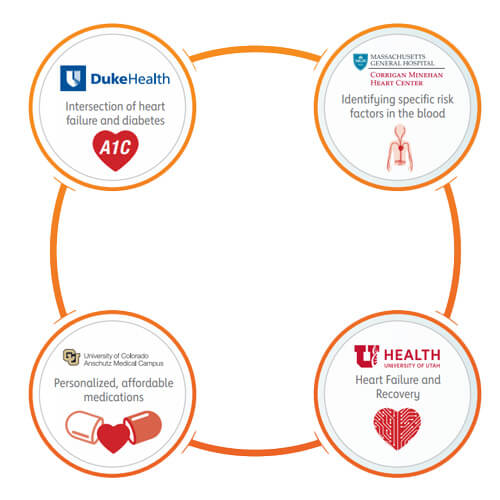Heart Failure: Collaborations and Conclusions
Collaborations
Throughout the SFRN award, researchers and fellows at the four centers provided information and samples from their respective projects and interacted with each other across disciplines. For example, Dr. Felker’s team needed more myocardial samples from patients with and without diabetes and heart failure. The center at UCD offered its “huge, robust tissue bank,” he said. “That project never could’ve happened successfully without that collaboration.”
The myriad of collaborations between centers was also instrumental in developing fellows’ experiences and enhancing a more promising future for research.
“There’s a lot of concern in the field about the pipeline of young investigators coming into research, because there are a lot of pressures,” Dr. Felker said. “A mechanism such as the SFRN provides fellows with the opportunity to be involved in high-quality research, didactic training, a chance to interact with scientists and fellows not just at their institution, but across all four institutions. This is valuable in terms of scientific growth and career trajectory.”
Dr. Rosenzweig said the SFRN gave researchers at MGH “the opportunity to not only interact with their colleagues, but to really reach outside their center and find synergy with other groups that are focused on the same problem.”

Conclusion
The American Heart Association Heart Failure Strategically Focused Research Network led to promising discoveries in diagnosis, prevention and therapy — with researchers identifying several medications that could be more effective at treating and ways doctors can show patients how to avoid heart failure.
Projects at the four centers have not only motivated fellows to continue research into heart failure, but also led to further funding from organizations including the AHA and NIH. The funds are integral to investigating a medical issue that, while slowly becoming better understood, remains a challenge.
“It’s a disease of older people and the population is aging,” said Michael Felker, M.D., Center Director at Duke. “Things that used to kill you, like heart attacks, now people are surviving, which is great, but they are left with long-term heart issues, of which heart failure is kind of the final common pathway.”
“People with heart failure are actually living longer, so the number of people out there with heart failure is greater. All those things make heart failure one of the most rapidly growing cardiovascular problems or medical problems of any kind. I think there has been a lot more progress on research in heart failure, but I think it’s only going to need to be more and more.”
“Collaborative efforts such as the SFRN are important for ensuring future medical strides,” said Khadijah Breathett, MD, a UCD fellow who now serves on another AHA Oversight Advisory Committee.
“If an individual is interested in developing a career as a physician scientist, this is a worthwhile endeavor,” she said. “It’s incredibly important to develop a foundation of research to be successful and competitive in our current research world.”
To discover new treatments for and revelations about heart failure, “it helps that we have national meetings that we can share ideas,” said David van Wagoner, PhD, Oversight Advisory Committee Chairperson. “But sometimes those connections are superficial, and when you get to the nuts and bolts of what you do day-to-day to manage the care or investigate the problem, it really helps to take things to a deeper level.”
“SFRNs provide opportunities for different centers to work together at that deeper level so there can be a sharing of specimens and data at the raw data level. You can get new insights into the data you’ve collected if you’re sharing it with somebody who has a different perspective. In addition, you can often pool data, so that any one center may have collected data on several hundred or several thousand patients. But if you combine three or four centers -- which is what the SFRNs do -- you can increase the sample size exponentially.”